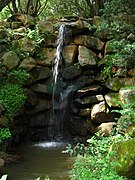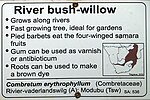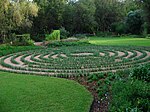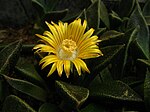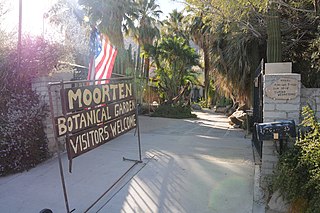
The Moorten Botanical Garden and Cactarium is a 1 acre (0.40 ha) family-owned botanical garden in Palm Springs, California, specializing in cacti and other desert plants. The gardens lie within Riverside County's Coachella Valley, part of the Colorado Desert ecosystem.

The University of California Botanical Garden is a 34-acre botanical garden located on the University of California, Berkeley campus, in Strawberry Canyon. The garden is in the Berkeley Hills, inside the city boundary of Oakland, with views overlooking the San Francisco Bay. It is one of the most diverse plant collections in the United States, and famous for its large number of rare and endangered species.

Phipps Conservatory and Botanical Gardens is a botanical garden set in Schenley Park, Pittsburgh, Pennsylvania, United States. It is a City of Pittsburgh historic landmark and is listed on the National Register of Historic Places.

The University of Michigan Matthaei Botanical Gardens includes botanical gardens, natural areas with trails, and several research-quality habitats and is part of the organization Matthaei Botanical Gardens and Nichols Arboretum. The conservatory is popular year round. The public entrance is at 1800 North Dixboro Road in Ann Arbor, Michigan. The grounds are open every day, but trails are not maintained in the winter. The conservatory, garden store, and lobby are open 7 days a week. The building complex is only closed on three holidays a year.
Susan Carter Holmes is a botanist and taxonomist. She discovered and catalogued more than 200 plants of the family Euphorbiaceae. Her plants and articles are published under her maiden-name Susan Carter.

The Orto Botanico di Palermo is both a botanical garden and a research and educational institution of the Department of Botany of the University of Palermo. The garden lies within the city of Palermo, Italy at 10 m (33 ft) above sea-level. It covers about 0.12 km2 on top of red soil that has evolved on a limestone tuff substratum.
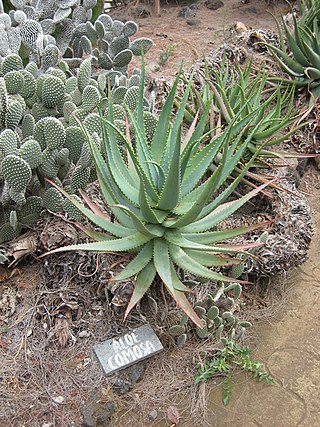
Aloe comosa is a species of flowering plant in the Asphodelaceae family. It is commonly called Clanwilliam aloe) and is endemic to South Africa.
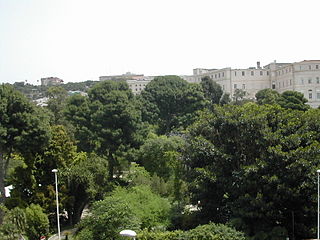
The Orto Botanico dell'Università di Cagliari, also known as the Orto Botanico di Cagliari, is a botanical garden operated by the University of Cagliari and located at Viale S. Ignazio da Laconi 9-11, Cagliari, Sardinia, Italy.

Leslie Charles "Larry" Leach was a Rhodesian taxonomic botanist.

The Botanischer Garten der Universität Regensburg is a botanical garden maintained by the University of Regensburg on campus at Universitätsstraße 31, Regensburg, Bavaria, Germany. It comprises 4.5 hectares. The garden is open daily except Saturday in the warmer months.

The Botanischer Garten Jena is the second oldest botanical garden in Germany, maintained by the University of Jena and located at Fürstengraben 26, Jena, Thuringia, Germany. It is open daily; an admission fee is charged.

The Botanischer Garten der Technischen Universität Dresden, also known as the Botanischer Garten Dresden or Dresden Botanical Garden, is a botanical garden maintained by the Dresden University of Technology. It is located in the north-west section of the Großer Garten at Stübelallee 2, Dresden, Saxony, Germany. It is open daily without charge.

The Huntington Desert Garden is part of The Huntington Library, Art Collections and Botanical Gardens in San Marino, California. The Desert Garden is one of the world's largest and oldest collections of cacti, succulents and other desert plants, collected from throughout the world. It contains plants from extreme environments, many of which were acquired by Henry E. Huntington and William Hertrich in trips taken to several countries in North, Central and South America. One of the Huntington's most botanically important gardens, the Desert Garden brought together a group of plants largely unknown and unappreciated in the beginning of the 1900s. Containing a broad category of xerophytes, the Desert Garden grew to preeminence and remains today among the world's finest, with more than 5,000 species in the 10 acre garden.

The Botanischer Garten der Ruhr-Universität Bochum, also known as the Botanischer Garten Bochum, is a botanical garden maintained by the Ruhr University Bochum. It is located at Universitätsstraße 150, Bochum, North Rhine-Westphalia, Germany, and open daily without charge.

The Botanische Gärten der Friedrich-Wilhelms-Universität Bonn, also known as the Botanischer Garten Bonn, is a botanical garden and arboretum maintained by the University of Bonn. It is located at Meckenheimer Allee 171, Bonn, North Rhine-Westphalia, Germany, and open except Saturdays in the warmer months; admission is free on weekdays.

The North-West University is a public research university located on three campuses in Potchefstroom, Mahikeng and Vanderbijlpark in South Africa. The university came into existence through the merger of the Potchefstroom University for Christian Higher Education, which also had a branch in Vanderbijlpark, and the University of North-West in 2004. With its merged status, the North-West University became one of the largest universities in South Africa with the third largest student population in the country.

The Stellenbosch University Botanical Garden located in the historical center of Stellenbosch is the oldest university botanical garden in South Africa. The Garden is relatively small and houses an enormous diversity of plants, both indigenous to South Africa and introduced species. It is open to the public.
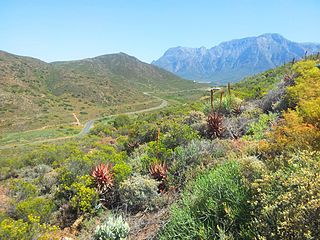
Robertson Karoo is a semi-arid vegetation type, restricted to sections of the Breede River Valley, Western Cape Province, South Africa. It is a subtype of Succulent Karoo and is characterised by the dominance of succulent plant species, and by several endemic plants and animals.

Peter René Oscar Bally was a Swiss botanical illustrator, botanist and taxonomist. The standard author abbreviation P.R.O.Bally is used to indicate this person as the author when citing a botanical name.

The Lisbon Tropical Botanical Garden is located between the Jerónimos Monastery and the Belém Palace, the official residence of the Portuguese president, in Belém, a few kilometers to the west of the centre of Lisbon. It occupies a total area of about 7 hectares, including a botanical park of about 5 hectares that is open to the public. Containing tropical, sub-tropical and temperate plants, the Garden is classified as a National Monument. Since 2015, the Garden has been part of the University of Lisbon.





